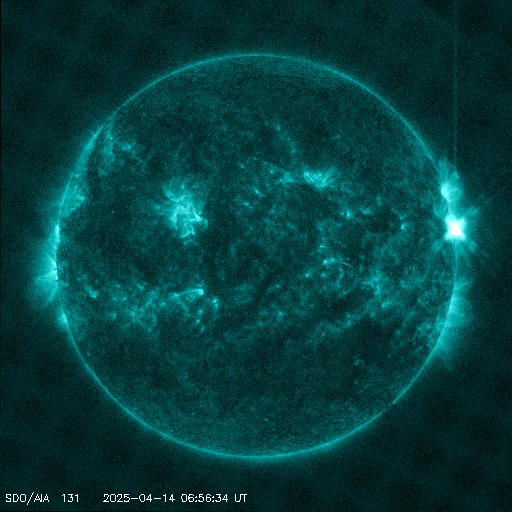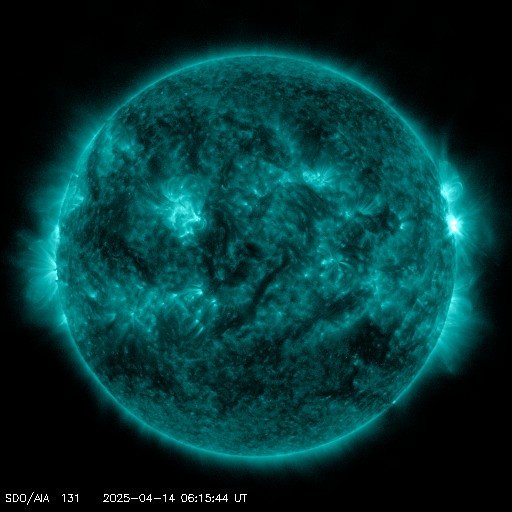Viewing archive of Thursday, 21 November 2019
Daily bulletin on solar and geomagnetic activity from the SIDC
Issued: 2019 Nov 21 1231 UTC
SIDC Forecast
Solar flares
Quiet conditions (<50% probability of C-class flares)
Geomagnetism
Quiet (A<20 and K<4)
Solar protons
Quiet
| 10cm flux | Ap | |
|---|---|---|
| 21 Nov 2019 | 070 | 012 |
| 22 Nov 2019 | 070 | 021 |
| 23 Nov 2019 | 070 | 005 |
Bulletin
The solar activity has been at very low levels over the past 24 hours. The Sun is currently spotless and the X-ray flux remains below B-level. However, a compact bright structure, located at low-latitude near the central meridian, has shown some evidence of activity. There is currently a low-latitude positive-polarity patchy coronal hole located in the Western Hemisphere. Solar activity is expected to remain at low levels for the next 24 hours.
There was a small filament eruption in the north west quadrant of the Sun. The eruption was observed to be moving predominantly to the west in coronagraph imagery. The plane-of-sky speed, as measure by CACTUS, reached around 650 km/s, and although the effects are expected to be small, the CME may arrive around mid day on 23-Nov-2019.
The greater than 10 MeV proton flux was at nominal values.
The solar wind speed has increased from around 300 to 500 km/s over the past 12 hours. The total magnetic field strength has fluctuated between 2 nT and 10 nT. The Bz component fluctuated around 0 nT, ranging between -7 and +8 nT. Geomagnetic conditions ranged between Kp index 0-2 (NOAA) and local K index 0-2 (Dourbes) over the past 24 hours.
Geomagnetic conditions have increased a little (K=2) due to the arrival of a high speed stream from a small low latitude positive polarity Coronal Hole around 21:00 UT yesterday. Geomagnetic conditions are expected to be enhanced at least over the next 24 hours.
Today's estimated international sunspot number (ISN): 000, based on 08 stations.Solar indices for 20 Nov 2019
| Wolf number Catania | 000 |
| 10cm solar flux | 070 |
| AK Chambon La Forêt | 005 |
| AK Wingst | 002 |
| Estimated Ap | 002 |
| Estimated international sunspot number | 000 - Based on 22 stations |
Noticeable events summary
| Day | Begin | Max | End | Loc | Strength | OP | 10cm | Catania/NOAA | Radio burst types | |
|---|---|---|---|---|---|---|---|---|---|---|
| None | ||||||||||
Provided by the Solar Influences Data analysis Center© - SIDC - Processed by SpaceWeatherLive
All times in UTC
Current data suggests there is a slight possibility for aurora to appear at the following high latitude regions in the near future
Whitehorse, YTAnchorage, AK, Fairbanks, AK, Juneau, AK
Latest news
Latest forum messages
Support SpaceWeatherLive.com!
A lot of people come to SpaceWeatherLive to follow the Sun's activity or if there is aurora to be seen, but with more traffic comes higher server costs. Consider a donation if you enjoy SpaceWeatherLive so we can keep the website online!

Latest alerts
07:09 UTC - Solar flare
Moderate M4.28 flare from sunspot region 4055
06:48 UTC - Radio Blackout
Minor R1 radio blackout in progress (≥M1 - current: M1.53)
06:24 UTC - Solar flare
Moderate M1.49 flare from sunspot region 4055
06:06 UTC - Radio Blackout
Minor R1 radio blackout in progress (≥M1 - current: M1.16)
04:45 UTC - Geomagnetic activity
Active geomagnetic conditions (Kp4) Threshold Reached: 04:29 UTC
Space weather facts
| Last X-flare | 2025/03/28 | X1.1 |
| Last M-flare | 2025/04/14 | M1.4 |
| Last geomagnetic storm | 2025/04/06 | Kp5 (G1) |
| Spotless days | |
|---|---|
| Last spotless day | 2022/06/08 |
| Monthly mean Sunspot Number | |
|---|---|
| March 2025 | 134.2 -20.4 |
| April 2025 | 132.1 -2.1 |
| Last 30 days | 132.4 -10.7 |





